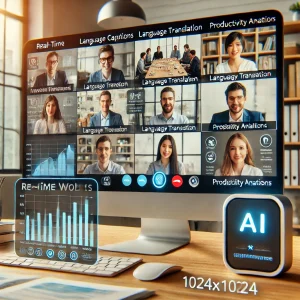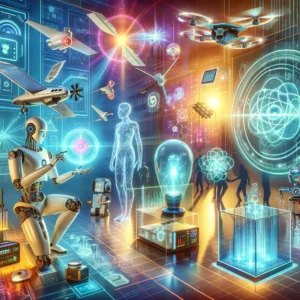

How AI Is Revolutionizing the Future of Remote Work
How AI Is Revolutionizing the Future of Remote Work: The shift toward remote work, accelerated by the COVID-19 pandemic, has fundamentally transformed the way people work. Now, artificial intelligence (AI) is becoming a key driver in this ongoing transformation, creating new opportunities and solving challenges unique to a distributed workforce. AI’s impact on remote work is vast, touching on everything from productivity to security and employee well-being.
In this article, we’ll explore the various ways AI is revolutionizing remote work and reshaping the future of digital workplaces. Whether you’re a business leader or a remote worker, understanding AI’s role in this landscape will help you stay ahead of the curve.
1. Enhancing Productivity and Efficiency
One of the most significant ways AI is reshaping remote work is by helping companies and individuals become more productive and efficient. AI tools and technologies are being integrated into daily workflows, optimizing tasks that were once time-consuming.
AI-Powered Task Management
AI-driven project management tools help remote teams prioritize tasks, track deadlines, and manage resources more effectively. These tools analyze data to predict potential delays, allocate resources more efficiently, and send reminders based on individual productivity patterns. For instance, tools like Trello and Monday.com incorporate AI to help remote workers stay on track, avoid missed deadlines, and prioritize tasks based on urgency and impact.
Automation of Routine Tasks
Repetitive tasks such as data entry, scheduling meetings, and responding to emails can be handled by AI-powered automation tools. This frees up time for remote workers to focus on more complex and creative work. AI chatbots, for example, can handle customer inquiries, providing prompt responses and only forwarding complex issues to human employees.
Intelligent Scheduling
Coordinating schedules in a remote work environment, especially across multiple time zones, can be challenging. AI-driven scheduling tools such as Clockwise and x.ai automate the process by finding mutually convenient meeting times and minimizing scheduling conflicts, which is a game-changer for remote teams. These tools consider factors like time zones, individual availability, and work preferences, making scheduling hassle-free.
2. Enhancing Collaboration in Virtual Environments
Remote work relies heavily on digital communication and collaboration tools. AI is enhancing these tools to make remote collaboration smoother and more efficient.
AI in Video Conferencing
Video conferencing platforms such as Zoom, Microsoft Teams, and Google Meet use AI to improve audio and video quality, reduce background noise, and even provide real-time captioning. AI can detect when a participant’s internet connection is unstable and make adjustments to keep the meeting running smoothly. In addition, some AI tools provide sentiment analysis, allowing team members to better understand each other’s moods and emotional states during virtual meetings.
Virtual Collaboration Spaces
AI is now being integrated into digital workspaces to provide real-time collaboration assistance. For instance, tools like Miro and Figma use AI to suggest design ideas, aid brainstorming sessions, and provide instant feedback on creative projects. By analyzing user actions, these AI-driven platforms can suggest edits, highlight trends, and even offer coaching tips to improve collaboration outcomes.
Language Translation and Transcription
AI-powered translation tools like Google Translate and iTranslate make it possible for teams in different countries to collaborate in their native languages, breaking down language barriers. Real-time transcription tools also facilitate smoother communication by creating written records of meetings and discussions, ensuring everyone remains on the same page.

3. Supporting Employee Well-being and Mental Health
The transition to remote work has introduced unique challenges to maintaining a healthy work-life balance. AI is helping employers monitor and support the well-being of their remote employees.
AI-Powered Mental Health Apps
Apps such as Wysa and Headspace use AI to offer guided mental health support, meditative practices, and mindfulness exercises. These apps are personalized, adapting to each user’s needs and offering tools to reduce stress, anxiety, and burnout—issues that can be exacerbated in a remote work environment.
Digital Well-being Monitors
AI tools can also monitor and analyze work patterns to detect signs of burnout. Microsoft’s MyAnalytics and other well-being analytics platforms offer insights into work habits, such as time spent on calls, late-night activity, and work hours outside typical patterns. These tools can alert employers to potential burnout risks and suggest actions to promote healthier work habits.
AI-Based Ergonomics
AI-driven ergonomics platforms, like Wellnomics, use machine learning to monitor posture, screen time, and movement. By offering real-time feedback, these tools help remote workers maintain better physical health, reducing the risk of eye strain, back pain, and other ergonomic issues associated with prolonged screen time.
READ ALSO: Eight Proven Strategies to Build a Scalable Business in Nigeria: Insights from Top Entrepreneurs
4. Enhancing Cybersecurity and Data Protection
Data security is a major concern in remote work, as employees work from various locations and often on personal devices. AI has significantly improved cybersecurity for remote teams by proactively identifying threats and enhancing data protection protocols.
AI-Powered Threat Detection
AI-driven security tools such as Darktrace and CrowdStrike are capable of identifying unusual patterns in network activity and detecting potential security threats in real time. They use machine learning algorithms to continuously improve their detection capabilities, protecting companies from data breaches and cyberattacks.
Automated Data Compliance
In remote work, ensuring data compliance across various devices and networks can be complex. AI-based compliance tools monitor data-sharing practices, alerting companies to any potential compliance violations. They can automatically encrypt sensitive information and restrict access based on company policies, minimizing the risk of accidental data exposure.
Identity Verification
AI tools like facial recognition and behavioral biometrics (e.g., keystroke patterns) are increasingly being used to verify the identity of remote workers, ensuring that only authorized personnel access sensitive information. These tools add an additional layer of security without burdening employees with frequent password changes or cumbersome two-factor authentication processes.
5. Personalized Learning and Development
Remote work allows employees to take advantage of flexible schedules for personal development. AI is transforming employee training and development, providing remote workers with tailored learning opportunities.
Adaptive Learning Platforms
AI-driven e-learning platforms like Coursera, Udemy, and LinkedIn Learning use adaptive learning technology to tailor content to individual skill levels, interests, and learning speeds. This personalization helps employees gain new skills more efficiently, filling skill gaps that may arise from remote work setups.
AI-Powered Mentorship
AI is being used to match mentors and mentees based on shared goals, skills, and preferences. For instance, platforms like Together and Chronus use AI to pair employees with mentors, facilitating skill transfer and career growth. This personalized approach to mentorship supports professional development in a remote work setting.
Knowledge Management
AI-powered knowledge management tools such as Notion and Confluence organize company knowledge, making it easy for remote workers to access information and learn from past projects. AI algorithms can suggest relevant documents, training materials, and answers to employee questions, streamlining the learning process.
6. Transforming Recruitment and Onboarding for Remote Teams
The recruitment and onboarding processes have adapted to remote work, and AI is playing a major role in making them more effective and efficient.
AI-Driven Candidate Screening
Recruitment platforms like HireVue and Pymetrics use AI to screen candidates, analyzing video interviews for body language, word choice, and tone. These platforms also use data from past successful hires to recommend ideal candidates, helping companies quickly find the best fit for their remote teams.
Virtual Onboarding Assistants
AI-powered virtual assistants help new employees transition smoothly by guiding them through onboarding procedures, answering common questions, and providing company resources. Chatbots like Mya and Rezo provide real-time support, ensuring new hires feel welcomed and informed, even if they’re onboarding remotely.
Skill Matching and Role Fit
AI tools also analyze candidates’ skills, preferences, and personality traits to match them with roles that align with their strengths. This data-driven approach ensures new hires are well-suited to remote work roles, reducing turnover and enhancing job satisfaction.
Conclusion
AI is fundamentally transforming the future of remote work by enhancing productivity, enabling smoother collaboration, and supporting employee well-being. It addresses the unique challenges of a distributed workforce while creating opportunities for growth, security, and continuous learning. As companies continue to embrace remote work, AI will play an increasingly critical role in shaping workplaces, making them more resilient, efficient, and supportive of employee needs.
For remote workers and business leaders alike, staying informed about AI’s capabilities and incorporating these tools can offer a competitive edge. By leveraging AI effectively, companies can optimize their remote work strategy, ultimately creating a more productive and connected workforce.





